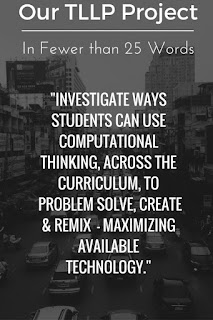Throughout the summer, I have been trying to learn more about computational thinking. It is a commitment I made to myself, and my peers, when we applied for a grant through the Teacher Learning and Leadership Program (TLLP). I detail the first steps in that journey here. Computational thinking is a way of approaching problems using key fundamentals from the computer sciences. A comprehensive explanation of it can be found at this site but, simplified, it typically involves decomposing a problem in order to see patterns that can then be used to create a method (or algorithm) for solving other similar problems. My team and I are attempting to “investigate ways that students can use computational thinking, across the curriculum, to problem solve, create and remix - maximizing available technology.” At least, that is a quick “elevator pitch” of our goal.
1. The Road Runner cannot harm the Coyote except by going "meep, meep."
The students and I could start by exploring the art work of well known minimalists (perhaps a few paintings by Yves Klein and Barnett Newman). Without introducing the term, minimalism, I will allow the students to decompose the art form to discover its essential elements. This interactive Google Slide could be shared with small groups for inquiry and discussion.
This will lead us to a brief discussion of minimalism - perhaps even investigating the music of modern composer Phillip Glass - and organize the rules that these artists embrace.
As a side note, the funny pseudo-Latin names given to our titular characters (carnivorous vulgarus & acceleratii incredibus respectively) leads nicely into Grade 6 Science - Life Systems)
I have been learning a lot about coding - the lessons available at code.org, Code Monkey and Scratch have been invaluable … and a lot of fun. The connections to math and science are easy and obvious. However, I did want to put more thought into how I might introduce computational thinking into my teaching of both art and literacy. Eventually, a podcast led me to an unexpected revelation - The cartoon team of Wile E. Coyote and his fleet-footed nemesis Roadrunner. It struck me that this classic Loony Tunes cartoon could be used to help teach both minimalism and writing within a framework. This is because each episode of the cartoon existed in a universe governed by a specific set of rules. Eleven, well articulated guidelines developed by the show's creator and animation director Chuck Jones to be followed by his writers.
The rules were as follows:
1. The Road Runner cannot harm the Coyote except by going "meep, meep."
2. No outside force can harm the Coyote -- only his own ineptitude or the failure of ACME products. Trains and trucks were the exception from time to time.
3. The Coyote could stop anytime -- if he were not a fanatic.
4. No dialogue ever, except "meep, meep" and yowling in pain.
5. The Road Runner must stay on the road -- for no other reason than that he's a roadrunner.
6. All action must be confined to the natural environment of the two characters -- the southwest American desert.
7. All tools, weapons, or mechanical conveniences must be obtained from the ACME Corporation.
8. Whenever possible, make gravity the Coyote's greatest enemy.
9. The Coyote is always more humiliated than harmed by his failures.
10. The audience's sympathy must remain with the Coyote.
11. The Coyote is not allowed to catch or eat the Road Runner.
So, here is my idea for a couple lessons and a culminating activity
The students and I could start by exploring the art work of well known minimalists (perhaps a few paintings by Yves Klein and Barnett Newman). Without introducing the term, minimalism, I will allow the students to decompose the art form to discover its essential elements. This interactive Google Slide could be shared with small groups for inquiry and discussion.
This will lead us to a brief discussion of minimalism - perhaps even investigating the music of modern composer Phillip Glass - and organize the rules that these artists embrace.
Once we have explored the elements of minimalism we will view two or three cartoons featuring Wile E. Coyote and the Roadrunner. The students will work in groups to determine the rules that they feel govern this cartoon world. I suspect that, after we debrief as a class and share our findings, we will uncover most of these rules through our own inquiry.
Students can now be tasked with writing their own episode - using either a script, storyboard or live tableaux format - respecting the rules decreed by Chuck Jones. As a group, they will present their script to the class. I will encourage them to explore as many Rube Goldberg-style devices as possible as their Wile E. Coyote character exhausts the warehouses at the ACME corporation. This video by the band OK GO is an additional way to introduce Rube Goldberg.
It will take a few test runs to formalize the efficacy of this series of lessons and activities. I will also fine tune it with the help of my TLLP team. In the end, I hope this serves to connect Computational Thinking to several Art Strands (Visual, Musical, Dramatic) and Literacy strands (Writing, Story Boarding, Oral Presentation) from the Ontario Curriculum.
It will take a few test runs to formalize the efficacy of this series of lessons and activities. I will also fine tune it with the help of my TLLP team. In the end, I hope this serves to connect Computational Thinking to several Art Strands (Visual, Musical, Dramatic) and Literacy strands (Writing, Story Boarding, Oral Presentation) from the Ontario Curriculum.
As a side note, the funny pseudo-Latin names given to our titular characters (carnivorous vulgarus & acceleratii incredibus respectively) leads nicely into Grade 6 Science - Life Systems)


No comments:
Post a Comment